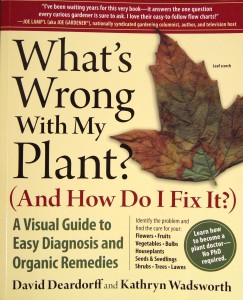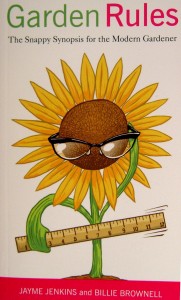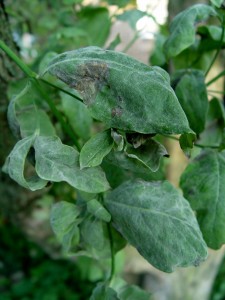Disease, Books and a Disease Book
July 5th, 2011
You’re not imagining things if it seems like your plants are more diseased than usual this year.
All of that spring rain, followed by a couple of warm and humid spells, is the perfect storm for all kinds of leaf disease.
I’m seeing a ton of mildew (whitish powdery look) on such plants as dogwood, lilac, beebalm, cucumber and ninebark, not to mention rust on crabapples, leaf spot on iris, anthracnose on dogwood, black spot on roses and early blight and Septoria leaf spot on tomatoes (earlier infections than most years).
Three factors are needed to fuel plant disease:
* Plants that are susceptible hosts to disease.
* The presence of a pathogen that affects the plants you’ve got.
* Favorable conditions for the pathogen to thrive.
If you hit that trifecta, the question now is what to do.
The Catch 22 of treating plant disease is that fungicides work best as preventatives. Wait until you have a full-blown, raging disease, and they aren’t terribly effective.
In other words, fungicides don’t cure disease so much as protect uninfected leaves from infection. Apply them too late and at best they just slow or prevent additional damage.
That means you have to apply fungicides before infection or at least as early in an outbreak as possible.
That approach can be wasteful, expensive, time-consuming and polluting — especially if it turns out you really weren’t going to have that bad of a problem anyway.
The good news is that most leaf diseases aren’t fatal to the plant.
They can stunt growth and lead to plant death after repeated outbreaks, but few diseases kill plants outright or overnight.
One of the best things you can do to combat disease is pick off infected leaves. That’s most helpful with soil-borne diseases like black spot and leaf spot that come from spores that splash up from the soil and work their way up the plant.
Removing fallen, diseased leaves from around infected plants is another good cultural move.
And so is applying a fresh coat of leaf and/or bark mulch each spring to prevent that splashing-up of soil-borne pathogens.
Selecting disease-resistant varieties in the first place is the best idea of all. 
I’ll be writing more about plant disease in my Patriot-News garden column on July 21 (also usually posted online at http://connect.pennlive.com/user/gweigel/index.html the day after).
In the meantime, check out the book “What’s Wrong With My Plant?” (Timber Press, 2009, $24.95 paperback). This is my absolute favorite aid for helping zero on in bug, disease and cultural troubles. It’s loaded with pictures to help gardeners match what’s ailing their own plants, and it offers detailed advice on how to deal with each problem.
Although you can’t take your garden with you to the beach, “What’s Wrong With My Plant?” would be the next best thing. It’s one of my top 10 favorite gardening books. The whole list is at https://georgeweigel.net/georges-favorite-plants-etc/my-10-favorite-gardening-books.
For other summer-reading ideas, here are a few of the more interesting new titles I’ve been perusing lately…
* “Garden Rules” by Jayme Jenkins and Billie Brownell (Cool Springs Press, $9.95 paperback).
This is a fun, pocket-sized, pithy and easy-to-read collection of tips, foibles and observations from a pair of gardeners who obviously get down and dirty. 
You’ll be smiling and shaking your head in understanding as Jayme and Billie muse about “zone denial,” deer woes, volcano-mulching, baking their potting soil to kill disease, and my favorite, “Free mulch falls from the sky.”
“It amazes me to see people take and bag leaves, then leave them at the curb for the city to pick up,” writes Billie. “Then they go out and buy mulch.”
Amen, sister.
* “Weeds: In Defense of Nature’s Most Unloved Plants” by Richard Mabey (HarperCollins, $25.99 hardcover).
When the subject of weeds comes up in a gardening book, it’s almost always about how to kill them.
Maybe Mabey has too much time on his hands, but he’s devoted much thought and study to the deeper meaning of weeds in this Michael Pollan-esque work.
Yeah, we might curse that bindweed that’s swallowing the specimen Hinoki cypress, but as Mabey says, “Weeds — even many intrusive aliens — give something back.”
After all, weeds were our first food, medicine and dye.
We really do need them to keep all of the unplanted soil from washing into the ocean.
And no class of plants is better at healing abused land than weeds, such as the 126 species of them that quickly sprang up in London’s World War II rubble (including the “bombweed”) and the cogon grass that managed to thrive soon after Agent Orange obliterated whole Vietnamese forests.
Though we may hate them, weeds deserve at least a little reverence, this book argues.
That thought might come in handy when you get back from vacation to find a jungle where your garden used to be.
* “Designing with Conifers” by Richard L. Bitner (Timber Press, $34.95 hardcover).
Here’s one from a local… Dr. Richard Bitner, a Lancaster Countian who’s an anesthesiologist at Hershey Medical Center when he’s not writing about plants.
This book makes the argument that no plants take more abuse than the evergreens we plant around the house.
“Mulch and meatballs” is the look Bitner calls it, and he comes to the rescue with better ideas on how to use conifers (cone-bearing plants) instead of those butchered yew balls and boxes seen everywhere.
A large part of the book takes a look at some of the specific, attractive conifers worth trying, such as a globe arborvitae called ‘Whipcord’ that looks like an exploding mound of shaggy goldish-green yarn and the gracefully weeping Alaska-cedar.
“It’s time to use conifers in more creative ways,” Bitner says.
Actually, it’s past time.
“High-Impact, Low-Carbon Gardening” by Alice Bowe (Timber Press, $24.95 paperback).
I wouldn’t call this a “light beach read,” but if you’re motivated to be a greener gardener, this book is the most thorough and detailed one I’ve seen yet.
It delves into every angle I would’ve thought about and a lot more, from the pros and cons of compost-tea brewing to eco-friendly wood and stone to learning what your weeds are telling you about your soil and gardening practices.
The only down side is that it’s written by a British designer, and so not all of the plants suggested are ideal ones for central Pennsylvania.
Otherwise, the information is practical and the photography is both instructional and beautiful (except for the shot of the worms being dumped into a bin on page 43).








